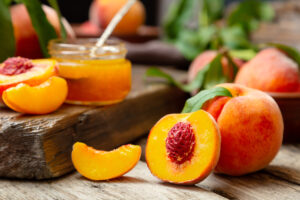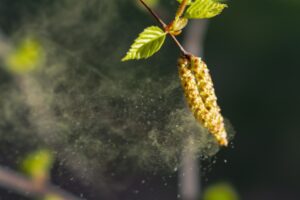What's On This Page?
ToggleHave you ever eaten a fresh apple and almost instantly felt your throat or mouth get itchy? It’s called Pollen Food Syndrome (PFS) and it has happened to me at times depending on where I bought the fruit – or more accurately where the fruit was harvested from! By the way, sometimes this reaction is called Oral Allergy Syndrome (OAS).
I know you’re thinking it could be the pesticides, and YES it certainly could. But it could also be pollen! Either will make your throat and mouth itch! What happens is swelling, inflammation or itching in or around the mouth and throat shortly after eating the offending food.
Have you ever considered pollen in your foods before?
You could be one of the 5 to 10% of people who experience Pollen Food Syndrome (PFS). It’s the term given to people who experience a mild local allergic reaction when eating foods associated with ragweed or birch pollen. There are many popular things listed below including melons, celery, peaches, tomatoes, and zucchini.

OAS can affect anyone but is more common in those who have asthma or suffer from hay fever caused by grass and tree pollen. Consuming raw fruits or vegetables can trigger immediate symptoms, showing that those with a heightened sensitivity to allergies are more susceptible. Adults are more likely to experience OAS than children.
Food Pollen Looks Structurally Like Pollen in the Air
This condition of Pollen Food Syndrome occurs when someone with pollen allergies has a negative reaction to proteins in certain raw foods that are structurally similar to pollen. It’s essentially a case of mistaken identity, where your immune system incorrectly identifies these food proteins as harmful pollen from trees, grass, or weeds.
So with PFS, the allergic reaction is local to the lips, mouth and throat. And with pollen in the air, your eyes may itch, or you may sneeze and have a runny nose and all that goes with that type of allergy. (READ SOLUTIONS HERE). You might like this article, Instead Of Your Antihistamine, Try These 10 Solutions.
Before I get into solutions and tips, I’d like to mention that none of the fruits or vegetables that cause PFS are in my Yummy Greens superfood drink mix. I know almost every single brand out there (other than my own) uses fruits, vegetables and grasses that are listed below as potentially full of pollen – but again, my formula does not. Yummy Greens is always goitrogen-free, so it doesn’t impact your thyroid hormone production.
The Basics of Pollen Food Syndrome
Pollen Food Syndrome is a cross-reactive condition where the body mistakenly recognizes the proteins in some fruits, vegetables, nuts, and cereals as tree, grass, or weed pollen. This misidentification leads to an allergic reaction localized mainly in the mouth and throat, characterized by itching or swelling.
PFS is more common in adults and teens with pre-existing pollen allergies, or asthma and it’s especially frequent during pollen season. These symptoms generally arise swiftly after consuming raw versions of the culprit foods. Interestingly, cooking can often deactivate these allergens, offering a simple solution to those affected.
Foods to Watch Based on Your Pollen Allergy
- Birch Pollen Allergies:
- Fruits: Apples, pears, peaches, cherries, plums, nectarines, kiwis, apricots, bananas
- Vegetables: Carrots, celery, parsley, peppers, raw potatoes
- Nuts: Hazelnuts, almonds, walnuts, pecans

- Grass Pollen Allergies:
- Cereals: Wheat, barley, rye, and sometimes corn
- Fruits: Melons (ie cantaloupe, honeydew), oranges, tomatoes
- Ragweed Pollen Allergies:
- Vegetables: Cucumbers, zucchini, squash
- Fruits: Bananas, cantaloupe, honeydew, watermelon, white grapes
- Seeds: Sunflower seeds
Give Them Up? Or Not?
You can certainly continue to eat these foods with my blessings and try one of the supplements suggested below to see if that mitigates the problem for you. You can also try avoiding them when the pollen season is high. Another option is to avoid these foods entirely – but that may be extreme if you love them. So let’s explore some practical adjustments to your diet that can significantly alleviate the symptoms of OAS.
- Cooking methods like steaming, baking, or sautéing fruits and vegetables can be more beneficial than consuming them raw.
- From my own experience, peeling fruits and vegetables can also be effective. So if you’re going to eat those delicious things listed above, try peeling them and see if that helps. xOften, the problematic proteins that trigger OAS symptoms are concentrated in the skins.
- Additionally, though it might not be the preferred option, eating canned or lightly processed versions of your favorite produce can help. The heat used during the processing helps break down the allergy-causing proteins.

- Keep in mind that the severity of OAS symptoms can fluctuate with the seasons. In spring and early summer, when pollen counts are high, those with specific pollen sensitivities may notice their reactions intensify. Check out the POLLEN MAP. The intensity of your ‘misery’ and symptoms can fluctuate based on the amount of pollen floating around in the air. During certain times of the year, typically spring and summer, pollen levels are much higher due to all the flowers and grasses in bloom. If you have OAS and find that you’re sensitive to specific pollens, you will suffer more frequently (or have worse reactions) during the peak pollen seasons.
- Food diary: If you ever want to get past this problem once and for all, keep a little notebook, or app on your phone where you can log reactions to certain foods. Since the reactions are immediate, it’s easy to ascertain what foods trigger you and what doesn’t.
Natural Alternatives and Solutions
You can’t simply flush food allergens from your system once they’re ingested, so avoiding the foods that cause your allergies is key. Additionally, you can manage symptoms with some natural remedies. Here are a few to consider:
- DAO (Diamine Oxidase) supplements: These supplements help break down histamine, potentially easing allergic reactions.
- Probiotics: Beneficial bacteria that can bolster the immune system and may reduce the intensity of allergic responses.
- Vitamin C and Quercetin: These act as natural antihistamines. They help stabilize mast cells, preventing them from releasing histamine, which is responsible for allergy symptoms.
- Green Tea: Studies indicate that green tea can decrease blood levels of IgE antibodies, crucial in the body’s allergic and inflammatory response. Its properties also help support the body’s defense mechanisms against allergies.
- Xolair®: A prescription medication aimed at reducing allergic reactions, typically used for severe cases under a doctor’s supervision.
Integrating these remedies can significantly aid in strengthening your body’s natural defenses and effectively managing allergy symptoms.
Summary
Pollen Food Syndrome is an unusual yet manageable condition. By understanding the link between your pollen allergies and the foods you eat, you can significantly reduce and manage your symptoms. Whether through cooking modifications, dietary adjustments, or natural supplements, the goal is to enjoy a diverse and nutritious diet without discomfort.
Always consult with a healthcare provider or allergist when managing health conditions through diet and lifestyle changes to ensure you’re taking the safest approach tailored to your specific needs. For more insights on how to live a healthier life with allergies, stay tuned to this blog. We’re here to provide you with the knowledge and tools to not just survive, but thrive!

Suzy Cohen, has been a licensed pharmacist for over 30 years and believes the best approach to chronic illness is a combination of natural medicine and conventional. She founded her own dietary supplement company specializing in custom-formulas, some of which have patents. With a special focus on functional medicine, thyroid health and drug nutrient depletion, Suzy is the author of several related books including Thyroid Healthy, Drug Muggers, Diabetes Without Drugs, and a nationally syndicated column.



